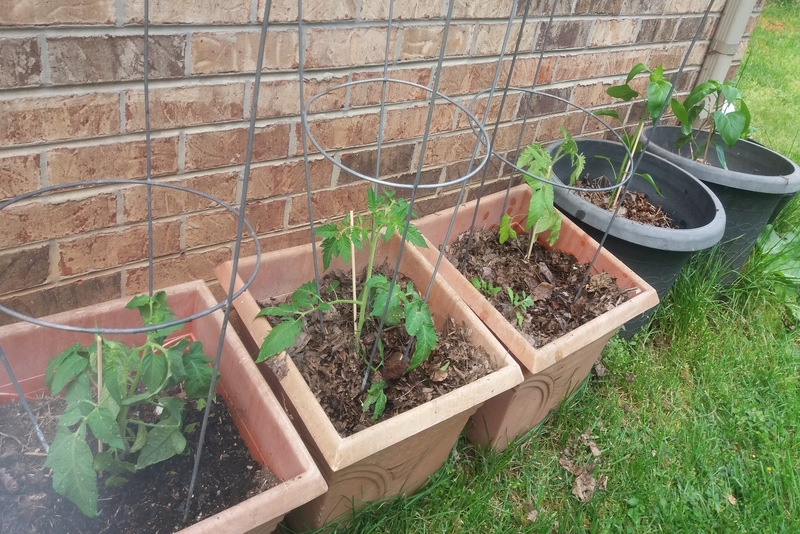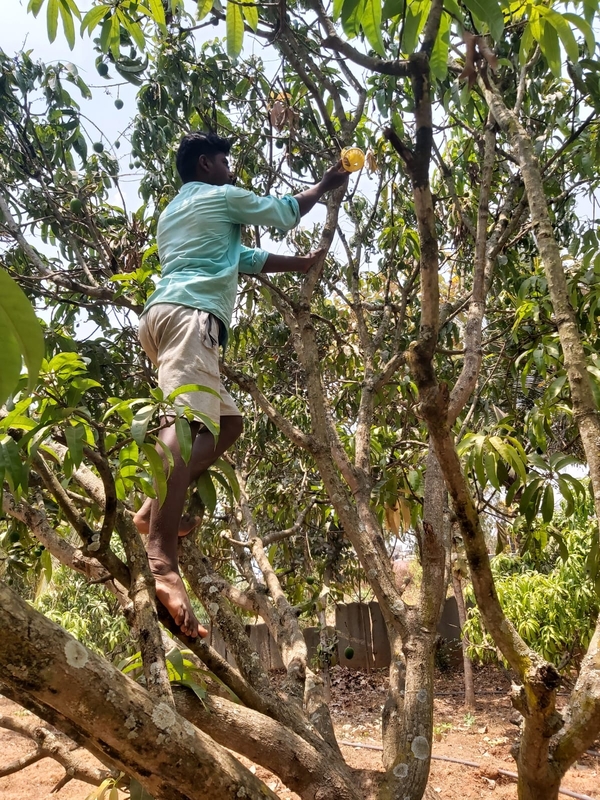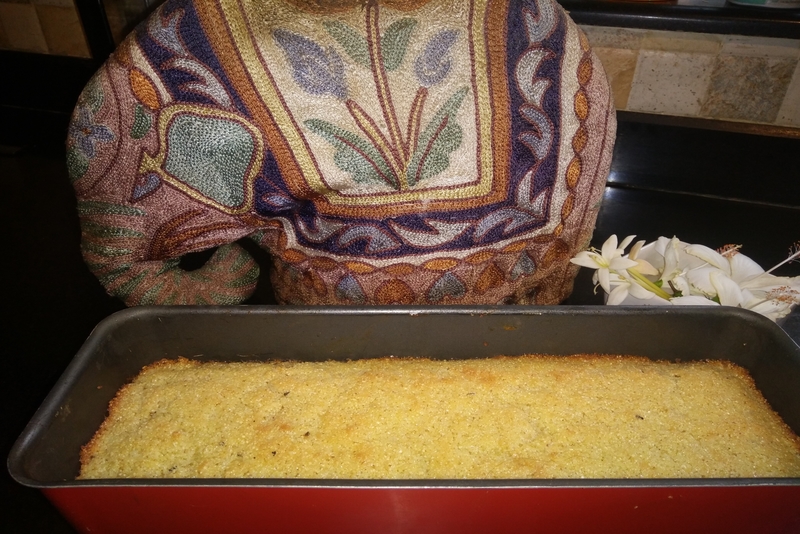Grow your own organic veggies, Tennessee, USA

Happily, the age of organic food is coming back full circle. Grow your own organic veggies, is the mantra a lot of tecchies and others are following all over the world.That’s cause veggies are being grown in everything including sewage back in my country, India and being fertilized and coloured with carcinogenic colours, to make them more attractive to buy. We have turned full circle to the western world type of earlier thinking, that only big and fat were the best produce, and covered with different pesticide as well. Today we all know organic is best, and organic is small and delicious with the original flavour of the produce.
Here in Tennessee in my sons home, they grow Okra (lady finger), Egg plant ( Brinjal) peppers and of course the all time favourite -- Tomatoes.My son is a cardiologist and so has saved a lot of people’s lives. Like Alaina says, “ My Daddy saves lives, that’s his job.” Many of his patients give him plants from their gardens as they know he loves gardening.
Yesterday he brought home a tray of tomato heirloom plants, in little pots that decompose as they are made of papier mache. Plastic is finding its way out thankfully with caring people. The tray contained, three large tomato plants and a heap of different peppers.I enjoy planting them in home made, rich organic kitchen waste, as the fruit will be completely safe for the kids to eat, straight off the tree like we did.
Marianna Peace was the first plant I put down and is an heirloom variety with old-fashioned tomato flavour. Pinkish-red, beefsteak-type, each fruit can grow upto 1 to 2 pounds with thick red flesh, with a perfectly balanced sweet, yet acidic flavor. A potato-leaf variety that will produce good yields of fruits. In local competitions, it was judged the best tasting tomato.
The second plant put down was "Better Boy" which was bred as an improved version of "Big Boy." It was bred to be resistant to common tomato diseases in addition to having "Big Boy's" extra-large fruit. While a "Better Boy" tomato plant set a Guinness World Record by producing more than 340 pounds of tomatoes from a single plant,one can, however, expect an abundant crop of deep red, 1-pound slicers that are ready to harvest in just 70 to 75 days.
“ Dig small holes to accommodate the root balls of "Better Boy" tomato seedlings in a sunny location that receives six to eight hours of direct sunlight a day, spaced 2 to 3 feet apart in rows spaced 4 feet apart. Plant can be set about 3 inches deeper than in their nursery pots to encourage more roots to develop along the stem for a stronger plant.
Erect plant stakes or tomato cages at this time, as doing it later poses the risk of injuring the plants. "Better Boy" will continue to grow in height, until killed by the frost and may reach heights of 4 to 6 feet in warm climates. However "Better Boy" requires support for the growing plant and resulting fruit, so a cage like I have put is best.
We water the "Better Boy" tomatoes once or twice a week to saturate the soil to the root level. During hot dry spells, your tomatoes may require more frequent watering. Mulch under your tomatoes with fistfulls of chopped leaves, to warm the soil, and create a weed barrier which also holds in moisture. However one has to prune the suckers from "Better Boy" tomato plants by grasping the sucker – a branch that appears between the main stem and a leaf – with your hands when it is 3 to 4 inches long and snapping it from the plant, says a gardening website.
The third plant we put down was Ten Fingers of Naples, which is fitting of its name and an Italian heirloom from Naples.The plant bears finger like trusses of medium-sized tomatoes Incredible yields of 4 oz., 4-5’ fruits with firm meaty flesh and a rich, savoury flavor with little seed, this fruit is; ideal for purée, salsa, sauces, and canning.” Love the thick flesh on these tomatoes. More dry than other varieties. Makes a great ketchup but is sweet enough to eat raw,” says a regular grower of this variety.
A mind boggling world of colour, shapes, and flavours makes peppers second only to tomatoes in popularity for veggie growers. One can find sweet, hot, or the snacking type for the garden.
In the tray we received, there were Bunker Green Bell Pepper plants. This is the perfect pepper for stuffing, freezing, and fresh eating in salads.My mother would lop off the top, fill them with a savoury pre-cooked mince and serve. The plants produce plenty of medium-sized green bell peppers with classic blocky bell shape. The plants may need staking as the fruit begin to grow and ripen. The plant grows well in a variety of climates and apparently is resistant to bacterial spot and pepper mottle virus.
He also gave us several Bonnie Green Bell Pepper. A hybrid sweet bell pepper this plant is a heavy yielder of large fruits. A good all-round pepper for slicing, stuffing, and freezing, this bell produces lots of fresh bell peppers gradually over the growing season. The resultant crop will vary based on care and the length of the growing season. We use stakes to help keep the plant upright.
Curiously the Sweet Banana Pepper is what we use in India for Pakoras. Named for its banana-like shape, this variety bears sweet, mild banana peppers that mature from yellow, to orange, and then to crimson red. The plant fruits prolifically, producing up to 25 to 30 pods per plant. Banana peppers are great for frying and pickling, and are an excellent choice for making pepper rings on your pies or for decoration on a party table.
The last plant we put down was the Serrano Hot Pepper. I found this closest to the hot chillies we get in India. This variety is a vigorous bearer of hot, pungent, thin fruit that mature from green to bright red. This pepper is growing in popularity for pickling and salsa, and is the pepper of choice for making our Indian green chutnies and pickles.
Try growing your own veggies. We do in both a veg patch as well as in large containers and freeze the extras.
Here in Tennessee in my sons home, they grow Okra (lady finger), Egg plant ( Brinjal) peppers and of course the all time favourite -- Tomatoes.My son is a cardiologist and so has saved a lot of people’s lives. Like Alaina says, “ My Daddy saves lives, that’s his job.” Many of his patients give him plants from their gardens as they know he loves gardening.
Yesterday he brought home a tray of tomato heirloom plants, in little pots that decompose as they are made of papier mache. Plastic is finding its way out thankfully with caring people. The tray contained, three large tomato plants and a heap of different peppers.I enjoy planting them in home made, rich organic kitchen waste, as the fruit will be completely safe for the kids to eat, straight off the tree like we did.
Marianna Peace was the first plant I put down and is an heirloom variety with old-fashioned tomato flavour. Pinkish-red, beefsteak-type, each fruit can grow upto 1 to 2 pounds with thick red flesh, with a perfectly balanced sweet, yet acidic flavor. A potato-leaf variety that will produce good yields of fruits. In local competitions, it was judged the best tasting tomato.
The second plant put down was "Better Boy" which was bred as an improved version of "Big Boy." It was bred to be resistant to common tomato diseases in addition to having "Big Boy's" extra-large fruit. While a "Better Boy" tomato plant set a Guinness World Record by producing more than 340 pounds of tomatoes from a single plant,one can, however, expect an abundant crop of deep red, 1-pound slicers that are ready to harvest in just 70 to 75 days.
“ Dig small holes to accommodate the root balls of "Better Boy" tomato seedlings in a sunny location that receives six to eight hours of direct sunlight a day, spaced 2 to 3 feet apart in rows spaced 4 feet apart. Plant can be set about 3 inches deeper than in their nursery pots to encourage more roots to develop along the stem for a stronger plant.
Erect plant stakes or tomato cages at this time, as doing it later poses the risk of injuring the plants. "Better Boy" will continue to grow in height, until killed by the frost and may reach heights of 4 to 6 feet in warm climates. However "Better Boy" requires support for the growing plant and resulting fruit, so a cage like I have put is best.
We water the "Better Boy" tomatoes once or twice a week to saturate the soil to the root level. During hot dry spells, your tomatoes may require more frequent watering. Mulch under your tomatoes with fistfulls of chopped leaves, to warm the soil, and create a weed barrier which also holds in moisture. However one has to prune the suckers from "Better Boy" tomato plants by grasping the sucker – a branch that appears between the main stem and a leaf – with your hands when it is 3 to 4 inches long and snapping it from the plant, says a gardening website.
The third plant we put down was Ten Fingers of Naples, which is fitting of its name and an Italian heirloom from Naples.The plant bears finger like trusses of medium-sized tomatoes Incredible yields of 4 oz., 4-5’ fruits with firm meaty flesh and a rich, savoury flavor with little seed, this fruit is; ideal for purée, salsa, sauces, and canning.” Love the thick flesh on these tomatoes. More dry than other varieties. Makes a great ketchup but is sweet enough to eat raw,” says a regular grower of this variety.
A mind boggling world of colour, shapes, and flavours makes peppers second only to tomatoes in popularity for veggie growers. One can find sweet, hot, or the snacking type for the garden.
In the tray we received, there were Bunker Green Bell Pepper plants. This is the perfect pepper for stuffing, freezing, and fresh eating in salads.My mother would lop off the top, fill them with a savoury pre-cooked mince and serve. The plants produce plenty of medium-sized green bell peppers with classic blocky bell shape. The plants may need staking as the fruit begin to grow and ripen. The plant grows well in a variety of climates and apparently is resistant to bacterial spot and pepper mottle virus.
He also gave us several Bonnie Green Bell Pepper. A hybrid sweet bell pepper this plant is a heavy yielder of large fruits. A good all-round pepper for slicing, stuffing, and freezing, this bell produces lots of fresh bell peppers gradually over the growing season. The resultant crop will vary based on care and the length of the growing season. We use stakes to help keep the plant upright.
Curiously the Sweet Banana Pepper is what we use in India for Pakoras. Named for its banana-like shape, this variety bears sweet, mild banana peppers that mature from yellow, to orange, and then to crimson red. The plant fruits prolifically, producing up to 25 to 30 pods per plant. Banana peppers are great for frying and pickling, and are an excellent choice for making pepper rings on your pies or for decoration on a party table.
The last plant we put down was the Serrano Hot Pepper. I found this closest to the hot chillies we get in India. This variety is a vigorous bearer of hot, pungent, thin fruit that mature from green to bright red. This pepper is growing in popularity for pickling and salsa, and is the pepper of choice for making our Indian green chutnies and pickles.
Try growing your own veggies. We do in both a veg patch as well as in large containers and freeze the extras.

Editor's Picks Articles
Top Ten Articles
Previous Features
Site Map
Content copyright © 2023 by Marianne de Nazareth. All rights reserved.
This content was written by Marianne de Nazareth. If you wish to use this content in any manner, you need written permission. Contact Marianne de Nazareth for details.





 -resizeimage.jpg.jpg)

